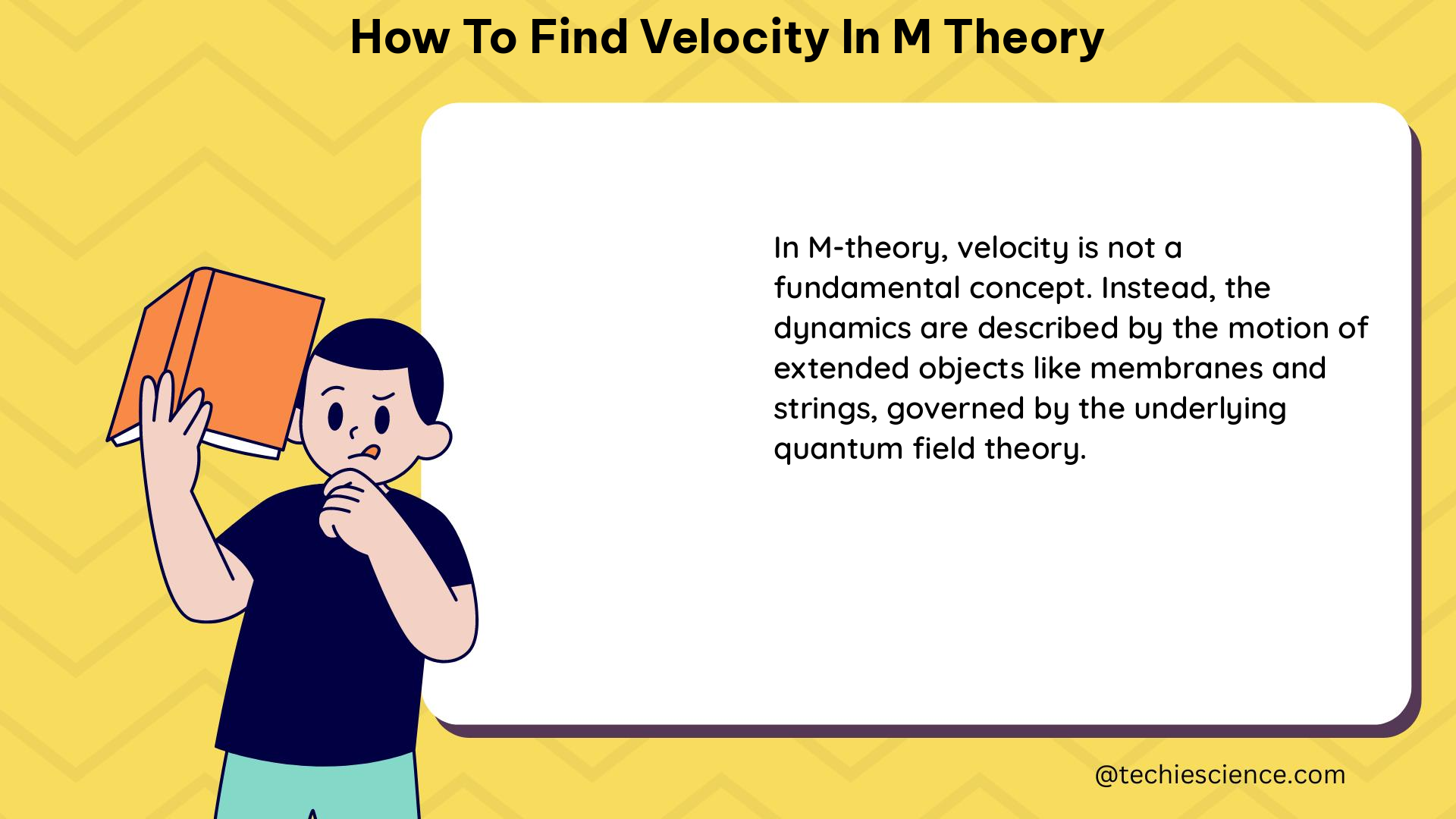M-theory is a proposed unified theory in physics that aims to reconcile the five consistent versions of string theory. In M-theory, the fundamental objects are one-dimensional strings, rather than point-like particles. These strings can have different vibrational modes, and these vibrational modes correspond to different particles with varying masses and spins. To find the velocity of a particle in M-theory, we need to understand the relationship between the vibrational mode of the string, the wave equation that describes the motion of the string, and the resulting momentum and velocity of the particle.
Understanding the Wave Equation in M-Theory
The wave equation that describes the motion of a string in M-theory is given by:
∂²u/∂t² = v² ∂²u/∂x²
Where:
– u is the displacement of the string
– t is time
– x is the position along the string
– v is the velocity of the wave on the string
To find the velocity of the wave on the string, we need to know the tension in the string (T) and the mass density of the string (μ). The velocity of the wave on the string is given by:
v = √(T/μ)
This equation tells us that the velocity of the wave on the string is determined by the tension and mass density of the string.
Relating Vibrational Mode to Particle Mass and Momentum

In M-theory, the momentum of a particle is given by the vibrational mode of the string. The mass of the particle is related to the square of the vibrational frequency of the string. Therefore, we can find the momentum of a particle by multiplying the mass of the particle by the velocity of the wave on the string.
The momentum of a particle (p) is given by:
p = mv
Where:
– m is the mass of the particle
– v is the velocity of the particle
Since the mass of the particle is related to the square of the vibrational frequency of the string, we can express the mass as:
m = ω²
Where:
– ω is the vibrational frequency of the string
Substituting this into the momentum equation, we get:
p = ω²v
Now, we can rearrange this equation to solve for the velocity of the particle (v):
v = p/ω²
This equation tells us that the velocity of the particle is given by the ratio of its momentum to the square of its vibrational frequency.
Numerical Example
Let’s consider a specific example to illustrate the process of finding the velocity of a particle in M-theory.
Suppose we have a string in M-theory with the following properties:
– Tension (T) = 10 N
– Mass density (μ) = 0.1 kg/m
We also know that the vibrational frequency of the string is 1000 Hz.
First, we can calculate the velocity of the wave on the string using the equation:
v = √(T/μ)
v = √(10 N / 0.1 kg/m)
v = 100 m/s
Next, we can calculate the mass of the particle using the relationship between the vibrational frequency and the mass:
m = ω²
m = (1000 Hz)²
m = 1,000,000 kg
Finally, we can calculate the momentum of the particle using the equation:
p = ω²v
p = (1,000,000 kg) × (100 m/s)
p = 100,000,000 kg·m/s
And the velocity of the particle is given by:
v = p/ω²
v = (100,000,000 kg·m/s) / (1,000,000 kg)
v = 100 m/s
Therefore, the velocity of the particle in this M-theory example is 100 m/s.
Additional Considerations
It’s important to note that the above example is a simplified case, and in real-world M-theory scenarios, the calculations may involve more complex equations and considerations, such as:
- The presence of multiple strings and their interactions
- The effects of higher dimensions in M-theory
- The influence of various forces and fields on the motion of the strings
- The role of quantum effects and the uncertainty principle in M-theory
Additionally, the experimental verification of M-theory and the measurement of its parameters are ongoing challenges in the field of theoretical physics.
Conclusion
In summary, to find the velocity of a particle in M-theory, you need to understand the wave equation that describes the motion of the strings, the relationship between the vibrational mode of the string and the mass and momentum of the particle, and the specific parameters of the system, such as the tension and mass density of the strings. By applying these principles, you can calculate the velocity of a particle in an M-theory framework.
References:
– Quantum field theory – Wikipedia. https://en.wikipedia.org/wiki/Quantum_field_theory
– Michelson–Morley experiment – Wikipedia. https://en.wikipedia.org/wiki/Michelson%E2%80%93Morley_experiment?wprov=sfla1
– Lecture 1 | String Theory and M-Theory – YouTube. https://www.youtube.com/watch?v=25haxRuZQUk

The lambdageeks.com Core SME Team is a group of experienced subject matter experts from diverse scientific and technical fields including Physics, Chemistry, Technology,Electronics & Electrical Engineering, Automotive, Mechanical Engineering. Our team collaborates to create high-quality, well-researched articles on a wide range of science and technology topics for the lambdageeks.com website.
All Our Senior SME are having more than 7 Years of experience in the respective fields . They are either Working Industry Professionals or assocaited With different Universities. Refer Our Authors Page to get to know About our Core SMEs.